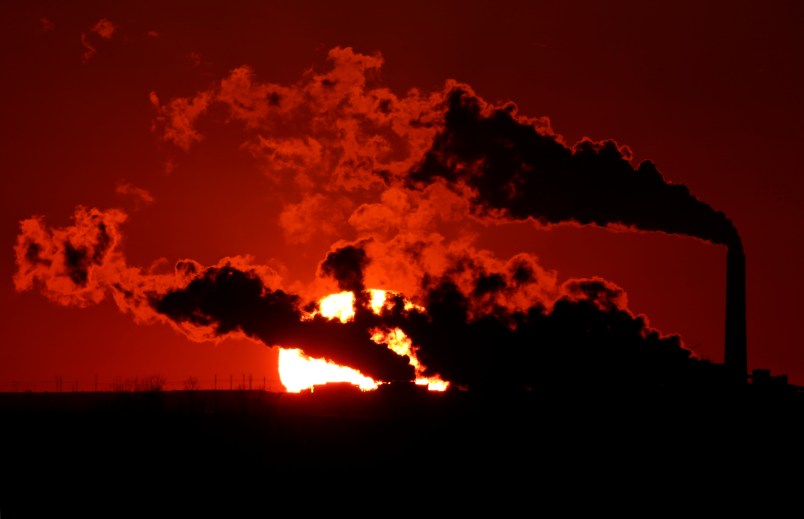WASHINGTON (AP) — The Obama administration took steps Wednesday to cut levels of smog-forming pollution linked to asthma, lung damage and other health problems, making good on one of President Barack Obama’s original campaign promises while setting up a fresh confrontation with Republicans and the energy industry.
In a long-awaited announcement, the Environmental Protection Agency said it prefers a new, lower threshold for ozone pollution of 65 to 70 parts per billion, but left open the possibility it could enact an even lower standard of 60 parts per billion sought by environmental groups. The current standard is 75 parts per billion, put in place by President George W. Bush in 2008.
Meeting the stricter rules will cost industry about $3.9 billion in 2025 if the government goes with a standard of 70 parts per billion, the EPA estimated. At a level of 65 parts per billion, the EPA said, the cost grows to $15 billion. But industry groups said the cost would actually be far higher and that it would be nearly impossible for refineries and other businesses to comply.
Pushing back on those claims, EPA Administrator Gina McCarthy said lower ozone standards would actually spur more businesses, investment and jobs by making communities healthier. She said states would be given time to carefully design plans to meet the new standard over the coming decades.
“Critics play a dangerous game when they denounce the science and law EPA has used to defend clean air for more than 40 years,” McCarthy wrote in an op-ed for CNN’s website. “The American people know better.”
Business groups like the National Association of Manufacturers painted the government’s move as a roadblock that threatens to jeopardize manufacturing’s comeback in the U.S. They accused the administration of moving the goalposts, since states are still working to implement the previous standard put in place in 2008.
“Tightening these standards could be the most expensive regulation ever imposed on the American public, with potentially enormous costs to the economy, jobs, and consumers,” said Jack Gerard, president of the American Petroleum Institute.
Sen. James Inhofe, R-Okla., who is to take over the Senate Environment and Public Works Committee in January, vowed “vigorous oversight” of the proposal in his new position.
Under the Obama administration, the EPA has issued or proposed the first regulations to control heat-trapping carbon dioxide, mercury and air toxins from power plants. The administration also has doubled fuel-efficiency standards for cars and trucks and clamped down on industrial pollution that blows downwind and contaminates other states.
The EPA was under a court-ordered Dec. 1 deadline to issue a new smog standard. But the proposal also fulfills a pledge Obama made during his first campaign for the White House and one of his first environmental actions as president: reversing Bush’s decision to set a limit weaker than scientists advised. In 2011, amid pressure from Republicans and industry, and facing a battle for re-election, Obama reneged on a plan by then-EPA administrator Lisa Jackson to lower the permissible level to be more protective of public health.
“Seldom do presidents get an opportunity to right a wrong,” said Bill Becker of the National Association of Clean Air Agencies, one of numerous advocacy groups that were enraged by the White House’s decision to table the first proposal.
Although the EPA is proposing a range of 65 to 70 parts per billion, the agency’s scientific advisers have endorsed a standard as low as 60 parts per billion. The EPA said it would take public comments on that lower level, too, leaving the door open to the possibility of even more stringent standards. The agency will also seek comments on the current standard of 75 parts per billion.
The initial range of 60 to 70 parts per billion proposed by the EPA in January 2010 would have doubled the number of counties in violation. Smog cities such as Los Angeles and Houston would have been joined by California’s Napa Valley and a county in Kansas with a population of 3,000.
The higher range now sought would mean fewer counties would be out of compliance than under the 2010 proposal.
Also, other air pollution rules will likely ease the burden on counties and states by reducing smog-forming ground-level ozone as a side effect. Ground-level ozone is created when pollutants from power plants, factories and automobiles react in sunlight.
States would have up to 20 years to meet the new limits, or could face federal penalties.
___
Follow Dina Cappiello on Twitter at www.twitter.com/dinacappiello
Copyright 2014 The Associated Press. All rights reserved. This material may not be published, broadcast, rewritten or redistributed.







Good.
Fact is, we have been subsidizing these industries either directly ($18.5b in 2014) and indirectly by not factoring in the cost of damage done to our health and shared environment. The fact that we are providing welfare to these freeloaders should be brought up every single instance Republicans (Landrieu included) go off on their war on coal/industry diatribe.